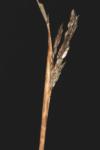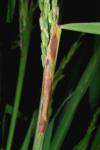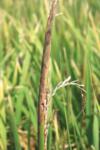What it does
Sheath Rot is caused by two fungal species, Sarocladium oryzae and Sacroladium attenuatum.
The disease reduces grain yield by retarding or aborting panicle emergence, and producing unfilled seeds and sterile panicles. Sheath Rot also reduces grain quality by causing panicles to rot and grains to become discolored.discolored.
Why and where it occurs
Sheath rot is present in most of the rice growing countries worldwide, particularly in rainfed rice ecosystems and is more prevalent during wet than dry seasons.
Sheath Rot incidence increases with increasing planting density and in plants that provide entry points for the fungus, in the form of injuries and wounds caused by insects such as stem borers at panicle initiation stage. The fungus tends to cause rotting of the uppermost leaf sheaths enclosing young panicles, which retards or aborts their emergence.
It can also occur in areas with high amounts of nitrogen fertilizer application and high relative humidity and temperatures (20−28°C) at heading to mature crop stages.
How to identify
Although sheath rot can be observed in the field as single disease on rice sheath, more often it has become part of a complex of grain and leaf sheath discoloration commonly observed on wet season rice.
Check for lesions.
The typical sheath rot lesion starts at the uppermost leaf sheath enclosing the young panicles. It appears oblong or as irregular spot with dark reddish, brown margins, and gray center or brownish gray throughout.
Check for spots.
Usually several spots are observed and these spots enlarge and coalesce or grow together and can cover most of the leaf sheath. Panicles remain within the sheath or may partially emerge. Affected leaf sheaths may have abundant whitish powdery fungal growth (mycelium) visible on the outer surface. Un-emerged panicles rot and florets turn red-brown to dark brown.
Sheath rot lesions are sometimes confused with sheath blight lesions. However, sheath rot occurs higher on the plant than sheath blight normally does and interferes with the panicle exsertion. Sheath blight occurs on leaves and lower portions of the plant and will not interfere with panicle exsertion. To confirm sheath rot infection, check for:
- lesions developing on the uppermost leaf sheaths that enclose the panicles,
- partially emerged or un-emerged panicles,
- rotting of the sheath,
- development of whitish powdery fungal growth on infected leaf sheaths, and
- unexserted panicles.
Click on images to enlarge
How to manage
- Sheath rot is a seed-borne disease, use healthy seeds.
- Minimize insect infestation in rice field. Insects cause injuries to the plants that allow the fungi to enter the plant and cause infection.
- The fungi survive on rice crop residue after harvest and can cause infection in following seasons.
- Remove infected stubbles after harvest.
- Use optimum plant spacing. Sow 3 plants per hill at 20 cm row spacing.
- Apply potash at tillering stage.
- Apply foliar spray of calcium sulfate and zinc sulfate.
- Apply a seed treatment fungicide like carbendazim, edifenphos, or mancozeb as seed treatment and foliar spraying at booting stage
- Apply a foliar fungicide like benomyl and copper oxychloride as foliar sprays.
Learn more
View full fact sheet:
Sheath rot on IRRI Rice Knowledge Bank




